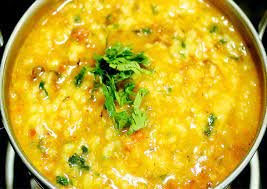Yellow Moong Dal, or split yellow mung beans, is a staple in Indian cuisine and a versatile ingredient that is both delicious and nutritious. This humble legume is a powerhouse of nutrients and makes for a comforting and hearty meal. In this article, we’ll explore the origins of Yellow Moong Dal, its nutritional benefits, and provide you with a simple recipe to prepare this classic dish.
A Brief History
Moong Dal has been a part of Indian cooking for centuries. It is believed to have originated in India, where it has been cultivated for thousands of years. This lentil is highly regarded not only for its taste but also for its numerous health benefits.
Nutritional Benefits
Yellow Moong Dal is a nutritional powerhouse, and here are some of the reasons why it’s so highly valued in Indian cuisine:
- Rich in Protein: Moong Dal is a great source of plant-based protein, making it an excellent choice for vegetarians and vegans.
- Fiber: It’s high in dietary fiber, which aids in digestion and keeps you feeling full for longer.
- Low in Fat: It’s naturally low in fat, making it a heart-healthy option.
- Vitamins and Minerals: Moong Dal is packed with essential vitamins and minerals like folate, iron, magnesium, and potassium.
- Antioxidants: It contains antioxidants that help protect your cells from damage.
Cooking Yellow Moong Dal
One of the most popular ways to prepare Yellow Moong Dal is as a simple and comforting stew. Here’s a basic recipe:
Ingredients:
- 1 cup Yellow Moong Dal
- 3 cups water
- 1 small onion, finely chopped
- 2 tomatoes, chopped
- 2-3 cloves of garlic, minced
- 1-inch piece of ginger, grated
- 1-2 green chilies, slit
- 1/2 teaspoon turmeric powder
- 1 teaspoon cumin seeds
- 1 teaspoon garam masala
- Salt to taste
- Fresh coriander leaves for garnish
- Ghee (clarified butter) or oil for tempering (optional)
Instructions:
- Wash and Rinse: Start by washing the Moong Dal under running water until the water runs clear.
- Pressure Cook: In a pressure cooker, add the washed Moong Dal, water, turmeric powder, and a pinch of salt. Pressure cook for about 2-3 whistles or until the Dal is soft and cooked through.
- Temper the Dal: In a separate pan, heat ghee or oil. Add cumin seeds and let them sizzle. Then, add chopped onions and sauté until they turn translucent. Add ginger, garlic, and green chilies, and sauté for a few more minutes.
- Add Tomatoes: Add chopped tomatoes and cook until they become soft and the oil starts to separate.
- Combine Dal: Transfer the cooked Dal into the pan with the tempering and stir well. Add garam masala and adjust the seasoning with salt.
- Simmer: Let the Dal simmer for a few minutes, allowing the flavors to meld together.
- Garnish: Garnish with fresh coriander leaves and a drizzle of ghee if desired.
Serve hot with rice or Indian bread such as roti or naan.
In conclusion, Yellow Moong Dal is not only a delicious and comforting dish but also a nutritional powerhouse. Its versatility in Indian cuisine and its numerous health benefits make it a beloved choice for many. Whether you’re a fan of Indian cuisine or looking for a nutritious addition to your diet, Yellow Moong Dal is a must-try dish that will delight your taste buds and nourish your body.
